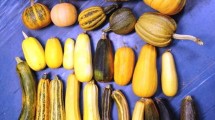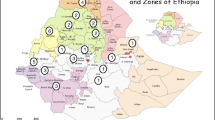Abstract
Striga hermonthica is a root hemiparasite that attacks onlyGramineae, includingSorghum and millet for which it is a principal cause of lowered yield. Enzyme electrophoresis was used to investigate genetic diversity inStriga hermonthica and to determine the level of differentiation between host-specialized populations. Nine genetic loci coding eight enzymes were interpreted and data obtained from three populations: oneSorghum-adapted population from Sudan and two populations from Burkina Faso, oneSorghum-adapted and the other millet-adapted. Levels of polymorphism were similarly high in all three populations (P=0.625, A=2.6−2.8, H=0.293−0.401). Genotypic frequencies at most loci conformed to Hardy-Weinberg expectations in each population, consistent with outcrossing as predicted from previous studies of floral biology. Occasional heterozygote deficiencies were probably the result of Wahlund effect. The mean value of FST over the three populations was 0.068, indicating a slight to moderate level of genetic differentiation among the populations. The two Burkina Faso populations were more closely related (S=0.940, D=0.006) than either was to the Sudan population, suggesting that geographic separation is more important than host specialization in contributing to population differentiation. TheSorghum-adapted population was slightly closer to the Burkina FasoSorghum-adapted population (S=0.873, D=0.047) than to Burkina Faso millet-adapted population (S=0.851, D=0.074). The absence of substantial genetic divergence between host-specific populations ofStriga could result either from recent evolution of host-specialized strains or from strong selection for physiological specialization in the face of substantial gene flow between the populations.
Similar content being viewed by others
References
Antonivics, J., Bradshaw, A. D., Turner, R. G., 1971: Heavy metal tolerance in plants. — Advances in Ecological Research7: 1–85.
Atsatt, P. R., 1970: Hemiparasitic flowering plants: phenotypic canalization by hosts. — Nature225: 1161–1163.
Bharathalakshmi, Jayachandra, 1979: Physiological variations inStriga asiatica. — InMusselman, L. J., Worsham, A. D., Eplee, R. E., (Eds.): Proceedings of the second international symposium on parasitic weeds, pp. 132–143. — Raleigh, N.C.: North Carolina State University.
Ferguson, A., 1980: Biochemical systematics and evolution. — New York: Wiley.
Gottlieb, L. D., 1981: Electrophoretic evidence and plant populations. — Prog. Phytochem.7: 1–46.
Hamrick, J. L., Linhart, Y. B., Mitton, J. B., 1979: Relationships between life history characteristics and electrophoretically detectable genetic variation in plants. — Ann. Rev. Ecol. Syst.10: 173–200.
Hartl, D. L., 1980: Principals of population genetics. — Sunderland, Mass.: Sinauer.
King, S. B., Zummo, N., 1977: Physiologic specialization inStriga hermonthica in West Africa. — Pl. Dis. Rep.69: 770–773.
Lewin, C. H., 1932: Witchweed (Striga lutea Lour. var.bicolor O. Kuntze). — Northern Rhodesian Dept. Agricult. Bull.2: 51–54.
Loveless, M. D., Hamrick, J. D., 1984: Ecological determinants of genetic structure in plant populations. — Annu. Rev. Ecol. Syst.15: 65–95.
Musselman, L. J., 1987: Taxonomy of witchweeds. — InMusselman, L. J., (Ed.): Parasitic weeds in agriculture. 1.Striga, pp. 3–11. — Boca Raton, Florida: CRC Press.
—, 1986: The witchweeds (Striga, Scrophulariaceae) of the Sudan republic. — Kew Bull.41: 205–221.
—,Mann, W. F., Jr., 1977: Host plants of someRhinanthoideae (Scrophulariaceae) of Eastern North America. — Pl. Syst. Evol.127: 45–53.
—, 1981: Studies on indigo witchweed, the American strain ofStriga gesnerioides (Scrophulariaceae). — Weed Science29: 594–596.
Nei, M., 1978: Estimation of average heterozygosity and genetic distance from a small number of individuals. — Genetics89: 583–590.
Nickrent, M., 1986: Genetic polymorphism in the morphologically reduced dwarf mistletoes (Arceuthobium, Viscaceae): an electrophoretic study. — Amer. J. Bot.73: 1492–1502.
Parker, C., Reid, D. C., 1979: Host specificity inStriga species: some preliminary observations. — InMusselman, L. J., Worsham, A. D., Eplee, R. E., (Eds.): Proceedings of the second international symposium on parasitic weeds, pp. 79–90. — Raleigh, N.C.: North Carolina State University.
Ramaiah, K. V., 1983:Striga research at ICRISAT, Upper Volta Center. — InRamaiah, K. V., Vasudeva Rao, M. J., (Eds.): Proceedings of the second international workshop onStriga. Ouagadougou, Upper Volta, pp. 53–60. — India: ICRISAT.
—, 1984: Physiological specialization ofStriga hermonthica and crop specificity. — InParker, C., Musselman, L. J., Polhill, R. H., Wilson, A. K., (Eds.): Proceedings of the third international symposium on parasitic weeds, pp. 58–65. — Aleppo, Syria: International Center for Agricultural Research in Dry Areas.
—, 1987a: Breeding cereal grains for resistance to witchweed. — InMusselman, L. J., (Ed.): Parasitic weeds in agriculture. 1.Striga, pp. 227–242. — Boca Raton, Florida: CRC Press.
—, 1987b: Control ofStriga andOrobanche species: a review. — InWeber, H. C., Forstreuter, W., (Eds.): Parasitic flowering plants, pp. 13–25. — Marburg: Philipps Universität.
Riopel, J. L., Baird, W. V., 1987: Morphogenesis of the early development of primary haustoria inStriga asiatica. — InMusselman, L. J., (Ed.): Parasitic weeds in agriculture 1,Striga, pp. 107–125. — Boca Raton, Florida: CRC Press.
Rogers, J. S., 1972: Measures of genetic similarity and genetic distance. — Studies in genetics, Univ. of Texas Publ.7213: 145–153.
Safa, S. B., Jones, B. M. G., Musselman, L. J., 1984: Mechanisms favouring outbreeding inStriga hermonthica (Scrophulariaceae). — New Phytol.96: 299–305.
Saunders, A. R., 1933: Studies on phanerogamic parasitism with particular reference toStriga lutea Lour. — Dept. Agricult. S. Africa, Sci. Bull.128: 1–57.
Swofford, D. L., Selander, R. B., 1981: Biosys-1: a FORTRAN program for the comprehensive analysis of electrophoretic data in population genetics and systematics. — J. Heredity72: 281–283.
Vasudeva Rao, M. J., Musselman, L. J., 1987: Host specificity inStriga species and physiological “strains”. — InMusselman, L. J., (Ed.): Parasitic weeds in agriculture. 1.Striga, pp. 13–25. — Boca Raton, Florida: CRC Press.
Verkleij, J. A. C., Bast-Cramer, W. B., Levering, H., 1985: Effects of heavy-metal stress on the genetic structure of populations ofSilene cucubalus. — InHaeck, J., Woldendrop, J. W., (Eds.): Structure and functioning of plant populations2, pp. 355–365. — Amsterdam: North Holland Publ.
Wahlund, S., 1928: Zusammensetzung von Population und Korrelationserscheinung vom Standpunkt der Vererbungslehre aus betrachtet. — Hereditas11: 65–105.
Werth, C. R., 1985: Implementing and isozyme laboratory at a field station. — Virginia J. Sci.36: 53–76.
—, 1984: Genetic uniformity in an introduced population of witchweed (Striga asiatica) in the United States. — Weed Science32: 645–648.
Wilson-Jones, K., 1953: The witchweeds of Africa. — World Crops5: 263–266.
—, 1955: Further experiments on witchweed control. 2. The existence of physiological strains ofStriga hermonthica. — Empire J. Agricult.23: 206–213.
Wright, S., 1978: Evolution and genetics of populations4, variability within and among natural populations. — Chicago: University of Chicago Press.
Workman, P. L., Niswander, J. D., 1970: Population studies on southwestern Indian tribes. 2. Local genetic differentiation in the Papago. — Amer. J. Hum. Genet.22: 24–29.
Worsham, A. D., 1987: Germination of witchweed seeds. — InMusselman, L. J., (Ed.): Parasitic weeds in agriculture 1,Striga, pp. 45–61. — Boca Raton, Florida: CRC Press.
Author information
Authors and Affiliations
Rights and permissions
About this article
Cite this article
Bharathalakshmi, Werth, C.R. & Musselman, L.J. A study of genetic diversity among host-specific populations of the witchweedStriga hermonthica (Scrophulariaceae) in Africa. Pl Syst Evol 172, 1–12 (1990). https://doi.org/10.1007/BF00937794
Received:
Accepted:
Issue Date:
DOI: https://doi.org/10.1007/BF00937794




